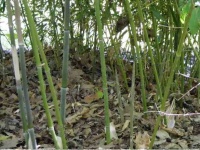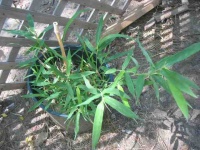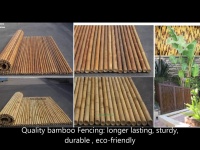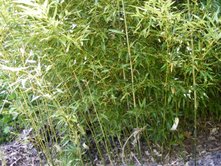Bamboo: Difference between revisions
No edit summary |
No edit summary |
||
| (21 intermediate revisions by 5 users not shown) | |||
| Line 1: | Line 1: | ||
[[File:bamboo1.jpg|200px|thumb|right|Bamboo]] | |||
What is the largest bamboo for Kansas City area | [[File:bamboo.jpg|200px|thumb|right|Bamboo]] | ||
Phyllostachys nuda is up to 34 feet and 2 inches in diameter, but the website: | |||
[[File:Bamboo fencing.jpg|200px|thumb|right|Bamboo fence.]] | |||
Bamboo is a member of the Grasses that is rigid like wood, yet grows like a grass. | |||
=Properties= | |||
* Remarkable [[Specific Strength]] (can be used as a building material) | |||
* A good source of [[Cellulose Biomass]] for production of cellulose based materials such as [[Reformed Cellulose]] | |||
* Antibacterial | |||
* Anti-fungal | |||
* Will crack after some time without chemical treatment | |||
* Bamboos include some of the fastest-growing plants in the world. Certain species grow 910 mm (36 in) in 24 hours. This rapid growth and tolerance for marginal land makes bamboo a good candidate for afforestation, carbon sequestration and climate change mitigation. | |||
=Risks= | |||
==Bamboo and toxicity== | |||
Uncooked bamboo shoots can be poisonous and should only be eaten if cooked the right way. | |||
Although bamboo as a material in itself is not toxic, some bamboo products carry toxins from pesticides from the cultivation stage or from binders from processing. Bamboo that has not been exposed to toxic chemicals are safe to use. Some people however have experienced allergic reactions to bamboo such as itchiness or rashes. Many bamboo products in the market, such as cutting boards or flooring, are held together by glue that contain formaldehyde which is carcinogenic. | |||
=Internal Links= | |||
*[[Engineered Bamboo Products]] | |||
*[[Biomass]] | |||
*[[Engineered Wood Products]] | |||
*[[Lignocellulosic Biomass]] | |||
=Introduction to OSE Use= | |||
What is the largest bamboo for growing in the Kansas City area ? | |||
''Phyllostachys nuda'' is up to 34 feet high and 2 inches in diameter, but the website: | |||
http://www.lewisbamboo.com/nuda.html | http://www.lewisbamboo.com/nuda.html | ||
says it will grow only 10 feet in zone 5. | says it will grow only 10 feet in zone 5. | ||
=Columbia, Missouri Example= | [[Image:bamboo2.jpg]] | ||
==Columbia, Missouri Example== | |||
'''Location:''' Columbia, Missouri | '''Location:''' Columbia, Missouri | ||
| Line 22: | Line 52: | ||
cannot do it quickly. | cannot do it quickly. | ||
[[ | =Uses= | ||
''(this section needs to be expanded)'' | |||
* construction material, panels (e.g. flooring) and scaffolding | |||
* [[Biocomposite|biocomposites]] and 3D printing filament | |||
* fabrics; clothing, rugs, etc. | |||
* water pipes | |||
* in agriculture (e.g. trellises), | |||
* decoration | |||
* food (e.g. bamboo shoots) | |||
* fuel | |||
* carbon sink | |||
* furniture | |||
* everyday objects; durable utensils, pens, cutting boards etc. | |||
[[ | =Treatments for Preservation= | ||
'''Chemical Treatment For Stuctural Use''' | |||
"Here's a mild chemical treatment recipe: Mix 10kg boric+15kg borax for 200lts water (warm enough to dissolve the borax in it). Puncture the bamboo nodes and fill it up with this solution. Let it stand saturated for a week. Let it dry and ta-daa, it's ready to be used!" [http://www.youtube.com/watch?v=APvpo2TKXUs] | |||
'''Heat Treatment''' | |||
(insert details here) | |||
compare to: [[Wood Preservation by Carbonization]] + bamboo composite | |||
=Bamboo [[Biocomposite|Biocomposites]]= | |||
* [http://www.sciencedirect.com/science/article/pii/S0261306912003883 "Bamboo fibre reinforced biocomposites: A review"] | |||
* example: [[polylactic acid|polylactic acid (PLA)]] | |||
=External Links= | |||
*[https://en.wikipedia.org/wiki/Bamboo The Wikipedia Page on Bamboo] | |||
[[Category:Food and Agriculture]] | [[Category: Growing plants]] [[Category: Food and Agriculture]] [[Category: Materials]] [[Category: Housing and construction]] | ||
Latest revision as of 14:05, 20 February 2021
Bamboo is a member of the Grasses that is rigid like wood, yet grows like a grass.
Properties
- Remarkable Specific Strength (can be used as a building material)
- A good source of Cellulose Biomass for production of cellulose based materials such as Reformed Cellulose
- Antibacterial
- Anti-fungal
- Will crack after some time without chemical treatment
- Bamboos include some of the fastest-growing plants in the world. Certain species grow 910 mm (36 in) in 24 hours. This rapid growth and tolerance for marginal land makes bamboo a good candidate for afforestation, carbon sequestration and climate change mitigation.
Risks
Bamboo and toxicity
Uncooked bamboo shoots can be poisonous and should only be eaten if cooked the right way.
Although bamboo as a material in itself is not toxic, some bamboo products carry toxins from pesticides from the cultivation stage or from binders from processing. Bamboo that has not been exposed to toxic chemicals are safe to use. Some people however have experienced allergic reactions to bamboo such as itchiness or rashes. Many bamboo products in the market, such as cutting boards or flooring, are held together by glue that contain formaldehyde which is carcinogenic.
Internal Links
Introduction to OSE Use
What is the largest bamboo for growing in the Kansas City area ? Phyllostachys nuda is up to 34 feet high and 2 inches in diameter, but the website: http://www.lewisbamboo.com/nuda.html says it will grow only 10 feet in zone 5.
Columbia, Missouri Example
Location: Columbia, Missouri
Source: Yuyi Lin
Attached are the bamboo photos taken early this year. The bush is large enough for us to harvest a few pounds of fresh bamboo shoots this year. It tasted really good. In my home town (Fujian Province, China), the soil is red colored, a little on acidic side, and mostly clay type, bamboo grows very well and become very large. I put oak leaves in Fall on the bush to help the root from cold winter. For last a few years, the leaves did not turn yellow but remain green all year round, which is helpful. I will look into using large bamboo stem as bow material, but cannot do it quickly.
Uses
(this section needs to be expanded)
- construction material, panels (e.g. flooring) and scaffolding
- biocomposites and 3D printing filament
- fabrics; clothing, rugs, etc.
- water pipes
- in agriculture (e.g. trellises),
- decoration
- food (e.g. bamboo shoots)
- fuel
- carbon sink
- furniture
- everyday objects; durable utensils, pens, cutting boards etc.
Treatments for Preservation
Chemical Treatment For Stuctural Use
"Here's a mild chemical treatment recipe: Mix 10kg boric+15kg borax for 200lts water (warm enough to dissolve the borax in it). Puncture the bamboo nodes and fill it up with this solution. Let it stand saturated for a week. Let it dry and ta-daa, it's ready to be used!" [1]
Heat Treatment (insert details here)
compare to: Wood Preservation by Carbonization + bamboo composite



